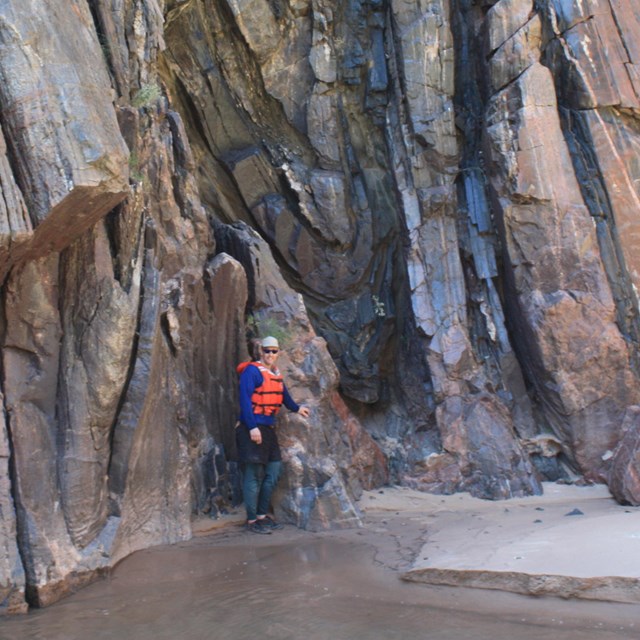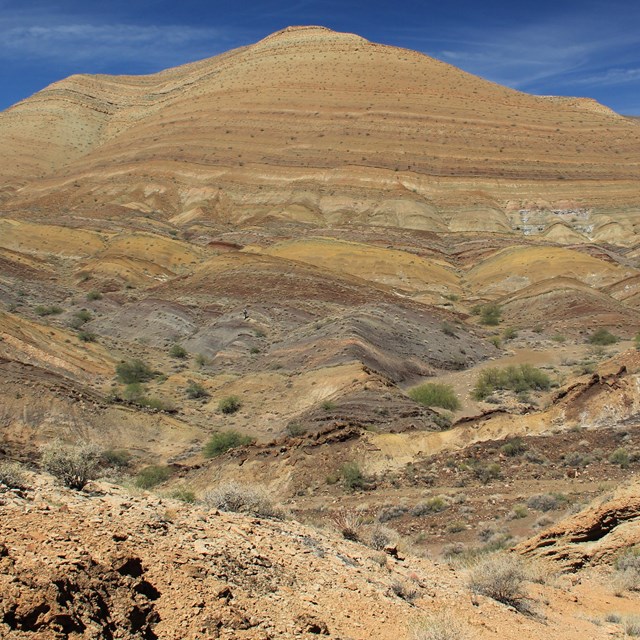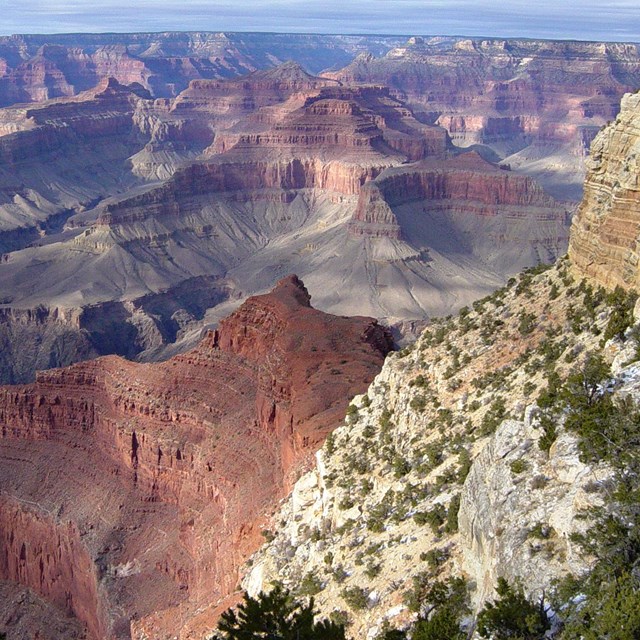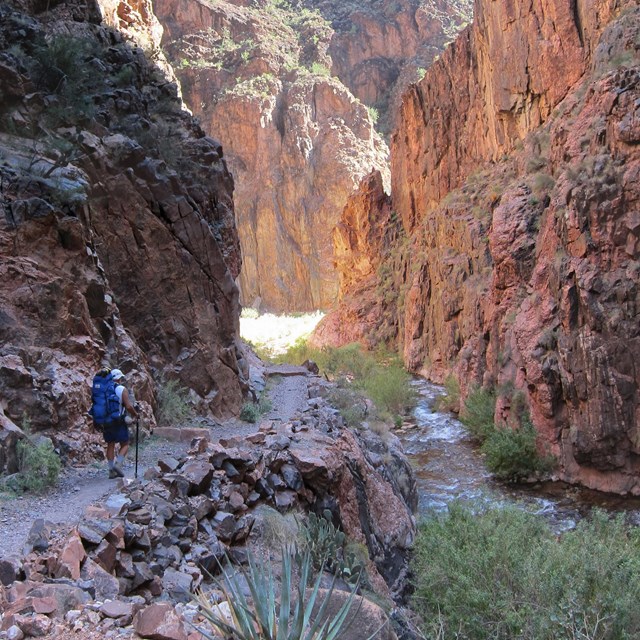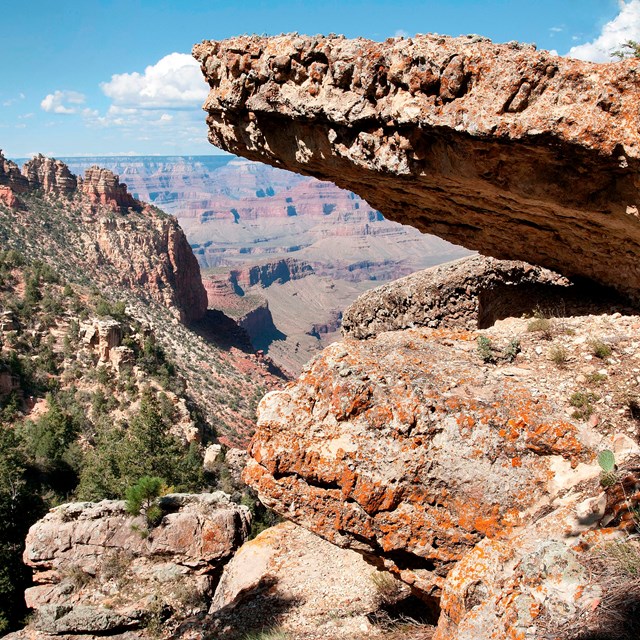Part of a series of articles titled Telling Time at Grand Canyon National Park.
Article
Telling Time at Grand Canyon National Park

NPS photo by M. Quinn.
Introduction
Grand Canyon National Park is all about time and timescales. Time is the currency of our daily life, of history, and of biological evolution. Grand Canyon’s beauty has inspired explorers, artists, and poets. Behind it all, Grand Canyon’s geology and sense of timelessness are among its most prominent and important resources.
Grand Canyon has an exceptionally complete and well-exposed rock record of Earth’s history. It is an ideal place to gain a sense of geologic (or deep) time. A visit to the South or North rims, a hike into the canyon of any length, or a trip through the 277-mile (446-km) length of Grand Canyon are awe-inspiring experiences for many reasons, and they often motivate us to look deeper to understand how our human timescales of hundreds and thousands of years overlap with Earth’s many timescales reaching back millions and billions of years.
This series of web articles provides the “best” numeric ages for the canyon’s strata based on recent scientific research. “Best” means the most accurate and precise ages available, given the dating techniques used, geologic constraints, the availability of datable material, and the fossil record of Grand Canyon rock units.
The Numeric Ages of Grand Canyon’s Three Sets of Rocks
From bottom to top, Grand Canyon’s rocks can be ordered into three “sets” (or primary packages), each with an overarching story.


-
The Vishnu Basement Rocks were once tens of miles deep as North America’s crust formed via collisions of volcanic island chains with the pre-existing continent between 1,840 and 1,375 million years ago.
-
The Grand Canyon Supergroup contains evidence for early single-celled life and represents basins that record the assembly and breakup of an early supercontinent between 729 and 1,255 million years ago.
-
The Layered Paleozoic Rocks encode stories, layer by layer, of dramatic geologic changes and the evolution of animal life during the Paleozoic Era (period of ancient life) between 270 and 530 million years ago.
Learn More
Supporting Information for the Numeric Ages of Grand Canyon’s Rocks
-
Geoheritage of Grand Canyon National Park’s Rock Record: Information related to the significance of Grand Canyon’s rock record and how it relates to the understanding of Earth’s history.
-
Missing Time at Grand Canyon National Park: The time missing on distinct erosion surfaces at the contacts between Grand Canyon’s three sets of rocks and other unconformities within the sets is a topic that can be as interesting as the time recorded.
-
Geologic Timescale, Geologic Dating Techniques, and Numeric Ages: Background information on the geologic time scale, geologic dating techniques and the use of numeric ages with different types of rocks.
Learn More
Photos and Illustrations
Telling Time at Grand Canyon National Park: 2020 Update
The information in this series of web articles includes information from the National Park Service Natural Resources Report Telling Time at Grand Canyon National Park: 2020 Update published in 2021. The authors' goal was to provide a single up-to-date reference that summarizes the main facets of when the rocks exposed in the canyon’s walls were formed and their geologic history.
This report is an authoritative and readable summary of the age of Grand Canyon rocks that provides scientific information for audiences at many levels of geologic understanding.

Karlstrom, K., L. Crossey, A. Mathis, and C. Bowman. 2021. Telling time at Grand Canyon National Park: 2020 update. Natural Resource Report NPS/GRCA/NRR—2021/2246. National Park Service, Fort Collins, Colorado. https://doi.org/10.36967/nrr-2285173. [IRMA Portal]
Meet the Authors
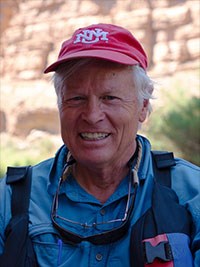
Dr. Karl Karlstrom is a Distinguished Professor of Geology at the University of New Mexico with a specialty in tectonics; he has researched Grand Canyon rocks of all ages over the past 35 years.
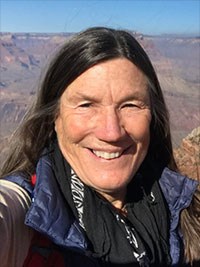
Dr. Laurie Crossey is a Professor of Geology and Geochemistry at the University of New Mexico who has worked on Grand Canyon rocks and water issues over the past 20 years.
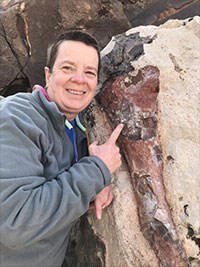
Allyson Mathis is a Research Associate with the Northern Rockies Conservation Cooperative, and a geologist by training. Allyson worked for the National Park Service at Grand Canyon National Park from 1999 to 2013.

Carl Bowman is a retired air quality specialist, formerly of Grand Canyon National Park, where he worked in various positions between 1980 and 2013.
Updates Since the 2021 Publication
These web articles include the following updates from the published Natural Resource Report:
-
In the geologic timescale, the boundary between the Jurassic and Triassic Periods was moved to 201.4 Ma, the boundary for the Cambrian and Neoproterozoic was moved to 538.8 Ma, the boundary for the Hadean and Archean was moved to 4,031 Ma, and the start of the Hadean was moved to 4,567 Ma based on Stratigraphic Chart v 2023/09 (Cohen et al. 2013).
-
The age of the Cardenas Basalt in the Unkar Group of the Grand Canyon Supergroup was revised to 1,082 Ma based on a newly available U-Pb radiometric date.
Related Links
-
Grand Canyon National Park (GRCA), Arizona—[GRCA Geodiversity Atlas] [GRCA Park Home] [GRCA npshistory.org]
-
International Commission on Stratigraphy—Chronostratigraphic Chart
Last updated: March 1, 2024

